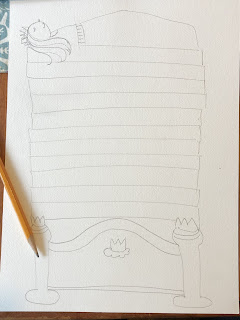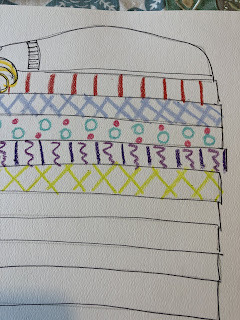With the Coronavirus in full swing here in the United States, schools have been let out for the remainder of the school year and the teachers have been sent home to teach online. I must admit that when this unusual journey began I thought "How on Earth am I going to teach art online and actually get the kids to participate?" Now going into my 3rd week of teaching online I feel like I am getting into a groove.
Normally at this time of the year, my 4th grade creates amazing dimensional Radial Symmetry designs using origami folds, bright colored construction paper, and glue.

With the bulk of my students having only basic art materials at home, I knew that even attempting the project would be a meltdown in the making for all of us! So I redesigned the lesson to use basic materials: paper, pencil, scissors, and color. Here is my step-by-step lesson for Radial Symmetry.
NOTE TO MY STUDENTS: Have fun with this project. Once you are finished, please post your completed design to the Google Classroom assignment post. Have fun! I can hardly wait to see what you come up with (((HUGS)))
Radial Symmetry
Materials:
Paper (whatever paper you have on hand will work fine. I used paper from my art journal)
Pencil
Eraser (just in case you make a boo-boo or want to change an area)
Scissors
Color (crayons, colored pencils, markers, watercolors...whatever you have on hand at home)
something round to trace (bowl, plate, lids, etc.)

Place your bowl, plate, round object onto your paper and trace all the way around. Once you have completed the circle, remove the plate, bowl, etc., then trace it one more time on a second sheet of paper. (NOTE: Be sure to help mom out and put it away when you are done!)
Cut out one of the circles. Cut carefully on the line! Throw away any trash (please).
Now we are going to do some folds. Take your time, matching up edges as you go.
First, fold your circle in half. Match up the edges (as shown), then press along the fold to create a crisp, clean edge (sorry, that sounds rather redundant, but I think you know what I mean)
Next, fold in half again. Press along the folds to create crisp, clean edges.
Finally, fold it one more time in half. If you have followed the directions, your circle will be divided into 1/8ths when you open it up!
Open the circle up, then get your scissors. We are going to cut 2 wedges out of the circle (NOTE: Only cut wedges out of ONE of the circles. Set the other circle aside). The first wedge should be a 1/8th wedge. The second should be a 1/4 wedge. Set the rest of your divided circle aside. It will give you extra pieces in case you change your mind about a shape you create or you just want additional details.
Now we are ready for some design fun! Let's start with the 1/8th wedge. Draw a random shape on the wedge. Be sure to incorporate the point (center of the circle) into your shape.
Cut out your shape carefully. Now you have 2 possible templates to use for the radial design!
Grab the circle you set aside. Fold it in half and then in half again, before opening it. Your circle should be divided into 1/4's.
Choose one of the templates to work with. I decided to use my petal shape and start the design. Place the point of your shape in the center of the circle as shown.
Make sure the point touches the center and the edge (as shown). Trace along the edges, all the way down to the center of the circle. Flip the template, line up with the next edge and trace again. (NOTE: You will need to flip the shape [think mirror image] for your design to work out. BUT if you forget or this step confuses you, I am sure it will work out fine. Don't stress!! 😱)
Continue around the circle until you have completed your first design element.
Now to work with the 1/4 wedge, but for this one I want you to fold the wedge in half first. Draw your shape on the folded edge. Any shape will work, but be sure the point is a part of the shape. You can see I drew a teardrop on my fold and that formed a heart once it was cut out.
This time I want you to use the template that has a curved edge. Position your template as shown, lining up the edges of the template with the folded lines of your circle and the curved edge with the curved edge of the circle.
Use the pencil to trace the shape inside the template. Once you have traced it once, move the template to the next 1/4 space and trace it a second time. Repeat until you have traced the shape 4 times.
Are you getting excited?? We are almost done! Now I want you to trace your template 4 more times. Can you guess where?? That is right! In the empty space. When you have that completed, your design should look something like this:
Now, of course, your shapes may be different than the ones I chose to use, so your design will not be identical to mine. But that is the way it should be...you guys know that "cookie-cutter Art" makes my skin crawl!
It is time to add your own extra details to the piece. I decided to trace a couple of bottle caps in the center. Maybe you decide to add a few more details around the edges. Just remember to keep whatever you do symmetrical!
Alrighty, I am going to stop the lesson now. Get your design completed to this point and then put it in a safe place (DON"T lose it!!).
For my 4th graders: post a photo of your progress to our Google Classroom assignment page. Next week we will work on color and texture and POP for our radial design.
Until then, I miss all of you terribly! I can hardly wait for us to be together again (((HUGS)))

























































